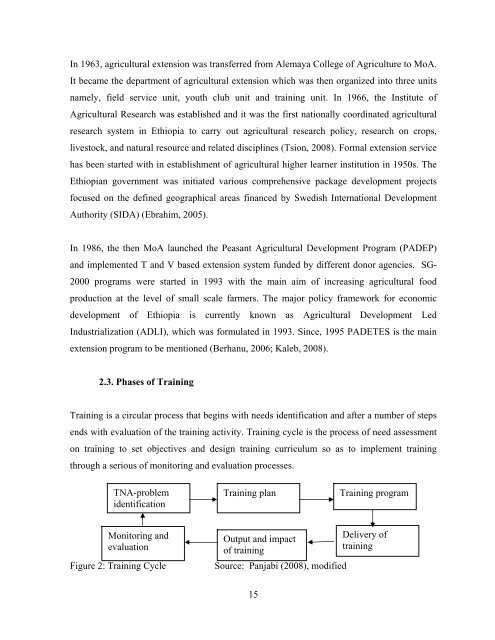effectiveness of modular training at farmers - IPMS Information ...
effectiveness of modular training at farmers - IPMS Information ...
effectiveness of modular training at farmers - IPMS Information ...
Create successful ePaper yourself
Turn your PDF publications into a flip-book with our unique Google optimized e-Paper software.
In 1963, agricultural extension was transferred from Alemaya College <strong>of</strong> Agriculture to MoA.It became the department <strong>of</strong> agricultural extension which was then organized into three unitsnamely, field service unit, youth club unit and <strong>training</strong> unit. In 1966, the Institute <strong>of</strong>Agricultural Research was established and it was the first n<strong>at</strong>ionally coordin<strong>at</strong>ed agriculturalresearch system in Ethiopia to carry out agricultural research policy, research on crops,livestock, and n<strong>at</strong>ural resource and rel<strong>at</strong>ed disciplines (Tsion, 2008). Formal extension servicehas been started with in establishment <strong>of</strong> agricultural higher learner institution in 1950s. TheEthiopian government was initi<strong>at</strong>ed various comprehensive package development projectsfocused on the defined geographical areas financed by Swedish Intern<strong>at</strong>ional DevelopmentAuthority (SIDA) (Ebrahim, 2005).In 1986, the then MoA launched the Peasant Agricultural Development Program (PADEP)and implemented T and V based extension system funded by different donor agencies. SG-2000 programs were started in 1993 with the main aim <strong>of</strong> increasing agricultural foodproduction <strong>at</strong> the level <strong>of</strong> small scale <strong>farmers</strong>. The major policy framework for economicdevelopment <strong>of</strong> Ethiopia is currently known as Agricultural Development LedIndustrializ<strong>at</strong>ion (ADLI), which was formul<strong>at</strong>ed in 1993. Since, 1995 PADETES is the mainextension program to be mentioned (Berhanu, 2006; Kaleb, 2008).2.3. Phases <strong>of</strong> TrainingTraining is a circular process th<strong>at</strong> begins with needs identific<strong>at</strong>ion and after a number <strong>of</strong> stepsends with evalu<strong>at</strong>ion <strong>of</strong> the <strong>training</strong> activity. Training cycle is the process <strong>of</strong> need assessmenton <strong>training</strong> to set objectives and design <strong>training</strong> curriculum so as to implement <strong>training</strong>through a serious <strong>of</strong> monitoring and evalu<strong>at</strong>ion processes.TNA-problemidentific<strong>at</strong>ionTraining planTraining programMonitoring andevalu<strong>at</strong>ionFigure 2: Training CycleOutput and impact<strong>of</strong> <strong>training</strong>Source: Panjabi (2008), modifiedDelivery <strong>of</strong><strong>training</strong>15
















